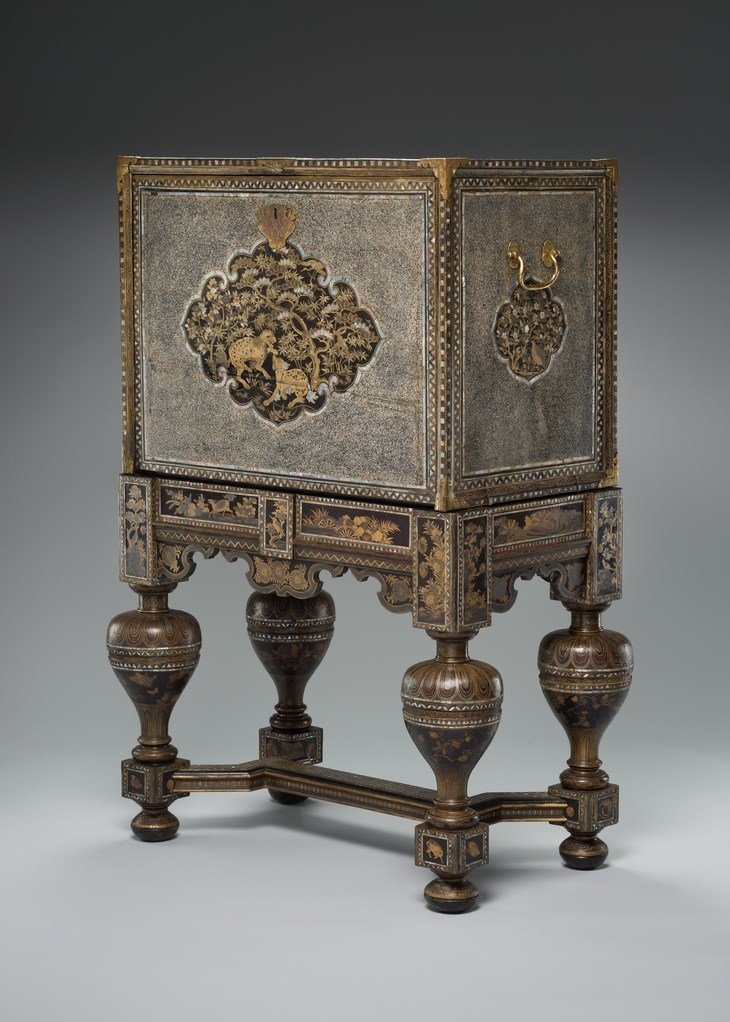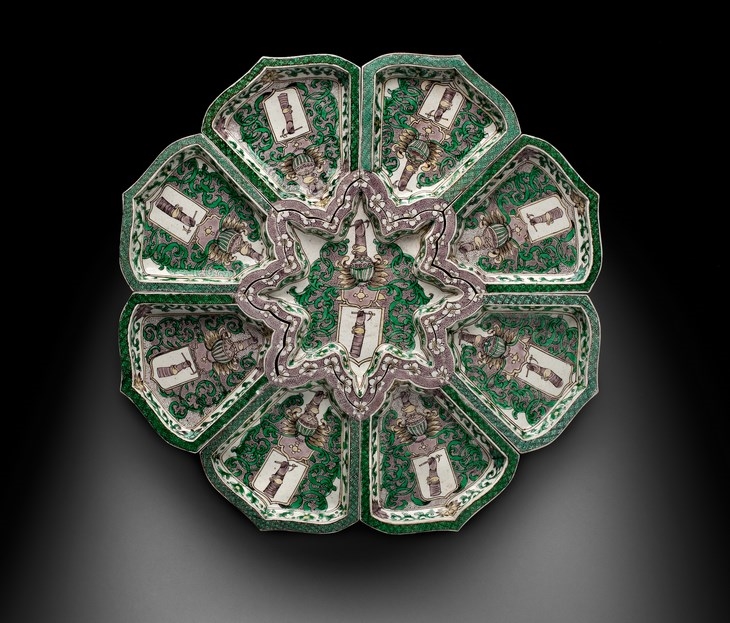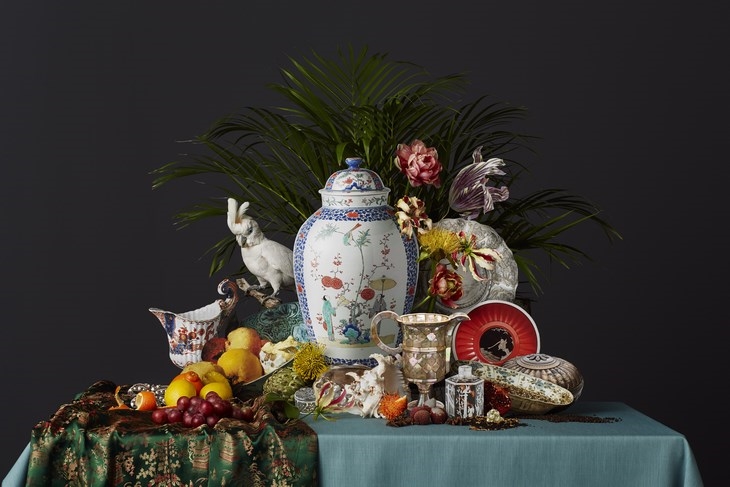The Rijksmuseum presents an exhibition of Asian treasure in Dutch interiors
The exhibition `Asia > Amsterdam; Luxury in the Golden Age` also presents many 17th century paintings: still-lifes and portraits of citizens who had themselves painted among their newly acquired items of Asian luxury. The exhibition is being organised in cooperation with the Peabody Essex Museum in Salem, USA. The loan items originate in such far-flung places as Moscow, St Petersburg, Versailles, London, Oxford, Madrid and Stockholm.
Sensation
Made of special, precious materials and adorned with intriguing exotic patterns no one had ever seen before, the Asian treasures caused a sensation in Amsterdam. With their colour and richness, they aroused the curiosity and stimulated the imagination of the Dutch bourgeoisie. Very fine white porcelain with blue designs from China, boxes displaying excellent lacquer work and ivory from Japan, gem-studded jewellery from India and Indonesia, silk fabrics from Japan, remarkably shaped shells, black ebony, filigree from India… the Dutch gasped at the beauty of it all and enthusiastically incorporated these treasures into their hitherto more modest interiors. It was also remarkable that not only the super rich could afford to buy these items, but also a large part of the growing middle class. All that precious luxury was shipped to Amsterdam – at that time ‘the world’s harbour’ – by the ‘world’s first multinational’, the Dutch East India Company.
Porcelain
The Chinese blue-and-white porcelain was especially popular. It was much thinner, smoother and lighter than the earthenware made in Holland. The making of earthenware was soon refined in Delft, leading to the famous ‘Delft Blue’, which therefore has Chinese origins. Coloured Japanese porcelain first appeared ca. 1660, imported by Dutch East India Company officials returning from the Far East. This created another sensation and, 20 years later, the exclusive and therefore expensive Kakiemon porcelain was the big favourite among the Dutch elite. The exhibition shows many excellent examples of porcelain bowls, dishes, cups and jugs with – as the pièce de résistance – a pouring jug with a golden lid from ca. 1640, bearing the coat of arms of its proud owner.
Lacquer
The Dutch were equally impressed with Japanese lacquer work, which was rarer and therefore more precious due to the complex and time-consuming production process. In the 17th century, a lacquered cabinet would cost about 180 florins, while a well-paid Dutch East India Company official made about 54 florins a month. Asia > Amsterdam shows a range of lacquer work of the highest quality, including two large lacquered chests. One was acquired by the Rijksmuseum two years ago and is heavily adorned with inlaid gold, silver, mother of pearl and even crystal. The other chest was specially made for the wife of Governor-General Van Diemen and bears her name. The Dutch were only able to acquire such exceptionally rare objects thanks to their position of trust in Japan. In this exhibition never before so much lacquer work of such high quality has been seen in the Netherlands.
Precious furniture
Asian interiors traditionally had little furniture and the furniture Dutch East India Company officials took with them failed to withstand the tropical climate. The Dutch therefore had furniture made from local types of wood. Asian furniture makers were shown examples of Western furniture, which resulted in Dutch cabinets produced from a combination of Eastern and Western materials and patterns. They were sometimes inlaid with ivory, as in the case of the extremely rare crib decorated with Hindu illustrations. Ivory was also used in other objects, such as small chests from Ceylon, one of which was decorated with a depiction of Adam and Eve under assignment from a local Dutch East India Company official.
Paintings
Not only diamonds, gems, filigree, mother of pearl, silver, silk, chintz and fans, but also pepper, tea and exotic animals such as parrots and monkeys were all shipped to Amsterdam. Naturally, Dutch citizens wanted to immortalise themselves among all that luxury. From the beginning of the 17th century, Dutch artists therefore started to incorporate these objects into their paintings. Clara Peeters, Floris van Dyck, Pieter Claesz, Willem Claesz. Heda and Willem Kalf were masters at depicting the texture of shiny porcelain. Men who wanted to be truly fashionable had their portraits done wearing a silk ‘Japanese skirt’, which was a long loose-fitting silk coat, such as the one worn by Amsterdam pharmacist Johannes Hudde in the portrait of him by Michiel van Musscher in 1686. Those who were also wealthy enough to serve Chinese tea from a Chinese teapot into Chinese cups, all on a Japanese lacquered table, had truly brought Asia to Amsterdam.
The exhibition “Asia > Amsterdam” was made possible thanks to Mondriaan Fund, ING and the Rijksclub.
The exhibition Asia > Amsterdam will be on view in the Peabody Essex Museum in Salem, US from February 27 till June 4, 2016
Asia > Amsterdam
Luxury in the Golden Age
17 October 2015-17 January 2016
Cover image credits: Joan Nieuhoff, Delftware plaque with chinoiserie-images, ca. 1670-1690
 PANEL WITH FLORAL STILL LIFE, DIRCK VAN RIJSWIJCK, 1654. WOOD INLAID WITH MOTHER OF PEARL. STAATLICHE KUNSTSAMMLUNGEN DRESDEN
PANEL WITH FLORAL STILL LIFE, DIRCK VAN RIJSWIJCK, 1654. WOOD INLAID WITH MOTHER OF PEARL. STAATLICHE KUNSTSAMMLUNGEN DRESDEN CABINET ON STAND, 17TH CENTURY. PEABODY ESSEX MUSEUM, SALEM, USA
CABINET ON STAND, 17TH CENTURY. PEABODY ESSEX MUSEUM, SALEM, USA CHINESE ARTIST, SWEETMEAT SET, C. 1690. PEABODY ESSEX MUSEUM, SALEM, USA
CHINESE ARTIST, SWEETMEAT SET, C. 1690. PEABODY ESSEX MUSEUM, SALEM, USA CABINET (WITH AN ELEPHANT HUNT AND THE ISLAND OF MATARA), C. 1660-1670. WOOD, TORTOISESHELL, OVERLAID WITH CARVED IVORY. THE ASHMOLEAN MUSEUM, OXFORD. PURCHASED WITH THE ASSISTANCE OF THE FRIENDS OF THE ASHMOLEAN MUSEUM
CABINET (WITH AN ELEPHANT HUNT AND THE ISLAND OF MATARA), C. 1660-1670. WOOD, TORTOISESHELL, OVERLAID WITH CARVED IVORY. THE ASHMOLEAN MUSEUM, OXFORD. PURCHASED WITH THE ASSISTANCE OF THE FRIENDS OF THE ASHMOLEAN MUSEUM BLOEMPIRAMIDE VAN DELFTS AARDEWERK, ANONYMOUS, C. 1690 – C. 1720
BLOEMPIRAMIDE VAN DELFTS AARDEWERK, ANONYMOUS, C. 1690 – C. 1720 CRADLE, ANONYMOUS, C. 1650 – C. 1700
CRADLE, ANONYMOUS, C. 1650 – C. 1700 PORTRAIT OF JOHANNES HUDDE (1628-1704), BURGOMASTER OF AMSTERDAM, MICHIEL VAN MUSSCHER, 1686
PORTRAIT OF JOHANNES HUDDE (1628-1704), BURGOMASTER OF AMSTERDAM, MICHIEL VAN MUSSCHER, 1686 PORTRAIT OF A FAMILY PLAYING MUSIC, 1663. PIETER DE HOOCH. CLEVELAND MUSEUM OF ART, GIFT FROM THE HANNA FUND
PORTRAIT OF A FAMILY PLAYING MUSIC, 1663. PIETER DE HOOCH. CLEVELAND MUSEUM OF ART, GIFT FROM THE HANNA FUND PHOTO ERIK SMITS/MONIQUE BRÖRING
PHOTO ERIK SMITS/MONIQUE BRÖRING WILLEM KALF, STILL LIFE WITH A CHINESE BOWL, A NAUTILUS CUP AND FRUIT, 1662
WILLEM KALF, STILL LIFE WITH A CHINESE BOWL, A NAUTILUS CUP AND FRUIT, 1662READ ALSO: JAMES TURRELL'S ENCOUNTER AT CULIACAN BOTANICAL GARDEN + PROJECT BRANDING BY SAVVY STUDIO